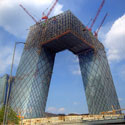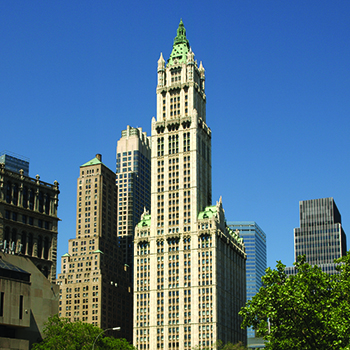Filter by
You must be a CTBUH Member to view this resource.
Woolworth Building
Cathedral of Commerce
Building
Completed, 1913
10007
residential / office
office
steel
241.4 m / 792 ft
58
33
150
34
3.55 m/s
120,773 m² / 1,299,990 ft²
You must be a CTBUH Member to view this resource.
You must be a CTBUH Member to view this resource.
Construction Start
Completed
Recladding
Retrofit Start
Retrofit End
Material Supplier refers to organizations which supplied significant systems/materials for a building project (e.g. elevator suppliers, facade suppliers, etc).
The Design Engineer is usually involved in the front end design, typically taking the leadership role in the Schematic Design and Design Development, and then a monitoring role through the CD and CA phases.
You must be a CTBUH Member to view this resource.
Usually involved in the front end design, with a "typical" condition being that of a leadership role through either Schematic Design or Design Development, and then a monitoring role through the CD and CA phases.
The Design Engineer is usually involved in the front end design, typically taking the leadership role in the Schematic Design and Design Development, and then a monitoring role through the CD and CA phases.
The main contractor is the supervisory contractor of all construction work on a project, management of sub-contractors and vendors, etc. May be referred to as "Construction Manager," however, for consistency CTBUH uses the term "Main Contractor" exclusively.
Other Consultant refers to other organizations which provided significant consultation services for a building project (e.g. wind consultants, environmental consultants, fire and life safety consultants, etc).
These are firms that consult on the design of a building's façade. May often be referred to as "Cladding," "Envelope," "Exterior Wall," or "Curtain Wall" Consultant, however, for consistency CTBUH uses the term "Façade Consultant" exclusively.
Material Supplier refers to organizations which supplied significant systems/materials for a building project (e.g. elevator suppliers, facade suppliers, etc).
Usually involved in the front end design, with a "typical" condition being that of a leadership role through either Schematic Design or Design Development, and then a monitoring role through the CD and CA phases.
The Design Engineer is usually involved in the front end design, typically taking the leadership role in the Schematic Design and Design Development, and then a monitoring role through the CD and CA phases.
Other Consultant refers to other organizations which provided significant consultation services for a building project (e.g. wind consultants, environmental consultants, fire and life safety consultants, etc).
These are firms that consult on the design of a building's façade. May often be referred to as "Cladding," "Envelope," "Exterior Wall," or "Curtain Wall" Consultant, however, for consistency CTBUH uses the term "Façade Consultant" exclusively.
Building Tall Lecture Addresses Skyscraper Renovations
29 November 2018 - Event
Milan Tall Building Conference
19 April 2016 - Event

01 March 2018
Kyoung Sun Moon, Yale University School of Architecture
The emergence of tall buildings in the late 19th century was possible by using new materials and separating the role of structures and that of...
The Woolworth Building was designed in the Neo-Gothic style by architect Cass Gilbert. Upon opening in 1913 the Woolworth Building was the tallest building in the world until the construction of 40 Wall Street in 1930. Its Gothic detailing at its crown is over-sized to be able to read from street level. The lobby is covered in marble with a vaulted ceiling, mosaics, stained-glass ceiling light and bronze fitting. In 2015, the upper floors were converted to residential.
Tallest building in the world 1913 - 1930. Preceded by the Metropolitan Life Tower and surpassed by the Bank of Manhattan

01 March 2018
The emergence of tall buildings in the late 19th century was possible by using new materials and separating the role of structures and that of...

26 October 2015
How New Generations, Industries and Workplace Paradigms Are Redefining the Commercial High-Rise
This paper will provide a data-driven analysis of building performance from three eras: the early 1900s, mid-twentieth century, and today. This longitudinal analysis will illustrate...

22 October 2015
Reinventing Woolworth: Adaptive Reuse of a Historic Skyscraper
This article presents a case study of structural and logistical issues involved in the adaptive reuse of an early 20th-century skyscraper, and outlines the case...

12 June 2008
The Tallest Buildings in the World: Past, Present & Future
Over time, the average height of the 100 tallest buildings in the world has been steadily increasing. However, by 2010, this average height will have...
29 November 2018
The latest event in the Building Tall Lecture Series, hosted by the Chicago Architecture Center and CTBUH, featured a panel on revitalizing iconic skyscrapers.
19 April 2016
The Tall Buildings Iuav International Conference held its sixth annual seminar at the CityLife Conference Hall in Milan.
28 October 2015
CTBUH 2015 delegates toured Woolworth Building which was the tallest building in the world at its completion in 1913.
Subscribe below to receive periodic updates from CTBUH on the latest Tall Building and Urban news and CTBUH initiatives, including our monthly newsletter. Fields with a red asterisk (*) next to them are required.
View our privacy policy